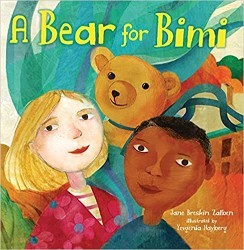It’s rare that the holidays of Rosh Hashanah and Ramadan occur at the same time. In fact, since Muslims use a purely lunar calendar and Jews use a lunar calendar adjusted for the solar year, the holidays only coincide around once every thirty years. In A Moon for Moe and Mo, the effect that this coincidence has on the lives of two ordinary boys living at opposite ends of Brooklyn’s Flatbush Avenue forms the premise of a surprisingly moving story. The surprise lies in the way that Zalben and Amini avoid creating an inspiring utopian parable, instead offering an understated tale of mutual respect and affection between two friends and their families — each who are enmeshed in their own cultures, but are open to the beauty of difference.
Zalben and Amini illustrate the many parallels between the boys, their families, and their cultural practices, communicating the beauty of coexistence in a lovely and subtle way. Zalben tells us that Moe and Mo look related to one another, with their “curly dark hair … brown eyes … [and] olive skin.” A two-page spread shows Moe and his mother, Mrs. Feldman, preparing traditional foods in their kitchen, as Mo and Mrs. Hassan do the same in theirs. The boys make a mess in each of their kitchens, with “pastry dough everywhere” and “chopped dates on the floor.”
Although a detailed explanation of Rosh Hashanah and Ramadan is included in the afterword, the story itself emphasizes customs rather than religious beliefs or rituals. Food in particular is shown to be an important element that links the boys and their cultures; the Rosh Hashanah rugelach are shaped like crescent moons, and, later in the story “the same moon watch[es] over both boys as they [sleep].” Collages on the endpapers visualize the significance of Middle Eastern food — apricots, cardamom, saffron, dates, mint, and olives — as a point of connection for Jews and Muslims. Recipes for the rugelach and date cookies from the story are included at the end, along with a heartfelt note from Zalben and Amini about how their own experiences led to them creating this story.
The boys’ fathers enter at the story’s end, when the two families enjoy a picnic in the park under the stars. Amini’s palette of bright colors and earth tones forms the background to a vibrant community with realistic details. This is not a fairy tale setting, but a real New York City with halal restaurants, bagel shops, taxis, and nail salons.
A Moon for Moe and Mo is highly recommended for readers from 3 to 8. Older children and adults will also appreciate the book’s message.
Emily Schneider writes about literature, feminism, and culture for Tablet, The Forward, The Horn Book, and other publications, and writes about children’s books on her blog. She has a Ph.D. in Romance Languages and Literatures.





